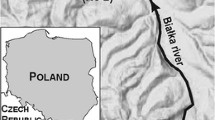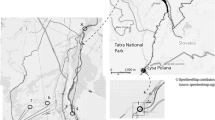Abstract
The objective of this work is the identification of the main contamination sources in the Vizela river watershed and the potential effects on water quality. The physico-chemical parameters temperature, pH, Total Dissolved Solids (TDS), electrical conductivity (EC), redox potential (Eh), chloride, fluoride, bromide, nitrite, nitrate, sulphate, and phosphate water contents were analysed. The microbiological parameters Escherichia coli and intestinal enterococci were monitored over the time. The obtained results indicate that the water located downstream the Vizela river is the most contaminated, although there has been an improvement in the water quality over the time. The microbiological contents are higher than parametric Portuguese values defined for human consumption, and often also for the parametric values defined for recreation water activities. As a preventive and monitoring measure, it is recommended to monitor the various physico-chemical and microbiological parameters in water points, with a spatial and temporal regular and constant monitoring.
Access provided by Autonomous University of Puebla. Download conference paper PDF
Similar content being viewed by others
Keywords
1 Introduction
Water quality in a watershed is one of the most relevant issue. Meeting water quality goals to sustain environmental quality in a large scale, multi-state water system is a challenge (Fernandez and McGarvey 2019). The increase in population over the last decades, as well as the occurrence of water stress areas, constitutes an important source of contamination for surface and groundwater (Negm et al. 2020). Water quality in a watershed is mainly controlled by anthropogenic activities and natural processes, which may be directly or indirectly influenced by the surface activities (Pratt and Chang 2012; Ai et al. 2015; Vasconcelos 2015; Belabed et al. 2017).
The industrial activities concentrated in the Valley of Ave river and the proliferation of energy production units have intensified the sources of contamination, mainly industrial and domestic ones. To recover the natural conditions of the Ave River, in 1999, a regional programme “Vale de Ave's depollution system” was implemented. However, after the application of this project, the ecological status of the river did not go beyond the classification of “poor quality”, according to the Portuguese Environment Agency (Rong et al. 2019). The objective of this work is the identification of local and diffuse contamination sources located in the Vizela River, aiming to improve the river water quality.
2 Study Area
The Ave river is in the North of Portugal, inserted in the Portuguese Hydrographic Region (RH2)—River Cávado, Ave and Leça (Agência Portuguesa do Ambiente 2015). It is about 98 km long. Along with its main tributaries, East River (right bank) and Vizela River on the left bank, it occupies an area of about 240 km2 (Soares et al. 1999).
The textile industry and agricultural activities are the principal activities. In the study area, the total annual rainfall is over 1400 mm, with the highest temperature in June (19.9 ºC) and the lowest one in November (11.5 ºC) (Brás 2018).
Five water points were selected and analysed, between July and October 2018, in the Vizela river watershed. The water points are spatially distributed from the Vizela river source (point V5) to the confluence with Ave river (point V1). The physico–chemical parameters: electrical conductivity (EC), temperature, pH, Eh, and Total Dissolved Solids (TDS) were determined in situ, and selected anions were determined by ion chromatography at the University of Minho (Braga, Portugal). The microbiological parameters (Escherichia coli and intestinal Enterococci) were determined between 2012–2017 (Câmara Municipal de Vizela 2018).
3 Results and Discussion
Water temperature is an indicator of water quality and will affect dissolved oxygen and pH values. The highest temperature value was obtained in September (V1 = 22º C), while the lowest one in October 2018 (V5 = 18.2º C). The pH value ranged between 6.9–7.9, without a significant temporal variation. Total dissolved solids (TDS) varied between 423 mg/L (point V1) and 18 mg/L (point V5), with a similar variation in electrical conductivity (EC; Fig. 1). In October, the highest TDS and EC values were obtained. The highest chloride water content was detected in October, although in the water points V4 and V5, no significant temporal variation was observed. The water sample V1 had a maximum content of 160.1 mg/L Cl−, with a significant temporal variation (Fig. 1).
Nitrite water content was higher in October than in July, except for water point V3. The water content showed a maximum of 4.5 mg/L NO2− (point V1) and a minimum of 0.050 mg/L NO2− (point V5). The water from V1, V2, and V3 were unsuitable for human consumption because NO2− content was above the Portuguese parametric value (0.5 mg/L) (Brás 2018). The highest SO42− water content was observed in October (points V1 and V4) and the lowest one in water from V5 (Fig. 1). The microbiological parameters showed the occurrence of Escherichia coli above the parametric value for recreation activities (Diário da República: 2007).
4 Conclusions
The obtained results show that water downstream the Vizela river is the most contaminated, although there has been an improvement in water quality in the river watershed over time, mainly since the creation of the regional programme, in 1999. Otherwise, upstream water presents the lowest contents in most of the analysed parameters, because it is closer to the natural spring of the Vizela river. Water contamination increases with distance from the source of the Vizela River. The microbiological parameters, represented by E. coli and intestinal Enterococci water content, were higher than parametric Portuguese legislated values indicated for human consumption and is also above the parametric value defined for recreation activities. The monitoring of water physico-chemical and microbiological parameters is strongly recommended in the Vizela river watershed including a spatial and temporal water network.
References
Agência Portuguesa do Ambiente: Plano de Gestão da Região Hidrografica do Cávado, Ave e Leça (RH2), Parte 2—Caracterização e diagnóstico da região hidrográfica, p. 273 (2015)
Ai, L., Shi, Z.H., Yin, W., Huang, X.: Spatial and seasonal patterns in stream water contamination across mountainous watersheds: linkage with landscape characteristics. J. Hydrol. 523, 398–408 (2015)
Belabed, B.E., Meddour, A., Samraoui, B., Chenchouni, H.: Modeling seasonal and spatial contamination of surface waters and upper sediments with trace metal elements across industrialized urban areas of the Seybouse watershed in North Africa. Environ. Monit. Assess. 189(6), 265 (2017)
Brás, A.F.S.: Avaliação dos riscos ambientais e qualidade da água numa bacia hidrográfica—caso de estudo no rio Vizela (Norte de Portugal). Unpublished Msthesis, University of Minho, p. 62 (2018)
Câmara Municipal de Vizela: Análises microbiológicas de 2012 a 2017 de Escherichia coli e Enterococos intestinais. Unpublish reports (2018)
Diário da República: Dec-Lei n.º 306/2007. Ministério do Ambiente, do Ordenamento do Território e do Desenvolvimento Regional, Série I, 5747 - 57652007 (2007)
Fernandez, L., McGarvey, D.: Water quality decisions and policy for an interstate watershed. Water Res. Econ. 27(100130), 1–13 (2019)
Negm, A., Bouderbala, A., Chenchouni, H., Barcelo, D.: Water Resources in Algeria - Part II: Water Quality, Treatment, Protection and Development. Springer, Cham (2020)
Pratt, B., Chang, H.: Effects of land cover, topography, and built structure on seasonal water quality at multiple spatial scales. J. Haz. Mat. 209–210, 48–58 (2012)
Rong, Q., Cai, Y., Su, M., Yue, W., Yang, Z., Dang, Z.: A simulation-based bi-level multi-objective programming model for watershed water quality management under interval and stochastic uncertainties. J. Environ. Manag. 245, 418–431 (2019)
Soares, H., Boaventura, R., Machado, A., Esteves da Silva, J.: Sediments as monitors of heavy metal contamination on the Ave river basin (Portugal): multivariate analysis of data. Environm. Pol. 105, 311–323 (1999)
Vasconcelos, A.S.: Estudo da qualidade da água do Rio Ave: relevância da relação entre indicadores mircrobiológicos, macroinvertebrados e parâmetros físico-químicos. P 162. Unpublished Msthesis, University of Porto (2015)
Author information
Authors and Affiliations
Corresponding author
Editor information
Editors and Affiliations
Rights and permissions
Copyright information
© 2022 The Author(s), under exclusive license to Springer Nature Switzerland AG
About this paper
Cite this paper
Antunes, M., Brás, A., Marinho, P. (2022). Water Quality Indicators in River Basins—A Portuguese Case Study (Northern Portugal). In: Chenchouni, H., et al. New Prospects in Environmental Geosciences and Hydrogeosciences. CAJG 2019. Advances in Science, Technology & Innovation. Springer, Cham. https://doi.org/10.1007/978-3-030-72543-3_113
Download citation
DOI: https://doi.org/10.1007/978-3-030-72543-3_113
Published:
Publisher Name: Springer, Cham
Print ISBN: 978-3-030-72542-6
Online ISBN: 978-3-030-72543-3
eBook Packages: Earth and Environmental ScienceEarth and Environmental Science (R0)





